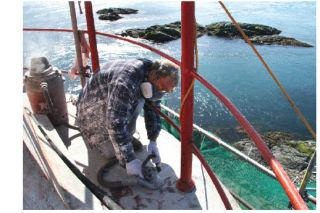| This article appeared originally at: http://www.bclocalnews.com/vancouver_island_south/goldstreamgazette/news/46944072.html
Published: June 04, 2009 1:00 PM
0 Comments
Tight quarters, gnarly winds and dizzying heights come part and parcel with this remote job site.
For father and son team Toby and Chris Tobiassen with TriCity Finishing, it’s worth it for the views from the top of Race Rocks Lighthouse. The pair have spent a month stripping layers of lead paint from the 149-year-old structure only so they can repaint its iconic red cap.
One particularly blustery morning the wind ripped the goggles right off of Toby’s head. It’s not uncommon for the paint to fly off the brush before even touching the walls. Conditions inside aren’t always easy either — every gallon of paint had to be hauled up more than 100 stairs.
Nothing parallels the view though, Chris said, and despite the island’s population of one, there is no shortage of company. The wildlife is abundant, evident in the elephant seal that greeted them on their first day of work.
The lighthouse sits within a marine ecological reserve on Race Rocks, an island about one nautical mile off Metchosin. Pearson College of the Pacific is the steward of the island, but the lighthouse is maintained by the Canadian Coast Guard. Part of a two-year project, the restoration work was commissioned to combat rust, broken window panes, peeling paint and an overall leaking structure.
The lighthouse was constructed in 1860 after a series of ships went down on the notorious rocks. Built to work in tandem with the Fisgard Lighthouse in Colwood, Race Rocks is the bigger of the two.
“Race Rocks sort of sticks out into the Strait and tells ships where to make the turn. Fisgard guided the ships the last 10 miles (into Esquimalt Harbour),” said Dale Mumford, Parks Canada community relations officer based at Fort Rodd Hill.
Fisgard was completed in November 1860, six weeks before Race Rocks, earning it the title of Canada’s first West Coast lighthouse.
That and the easy access to the site garnered it federal heritage status, something yet to be granted to Race Rocks lighthouse, Mumford said. The lighthouses were the only two built during the colonial period, he added.
NOTE: This is incorrect as Race Rocks was designated a heritage Structure in 1991
The lighthouses were funded by a loan from the British government that the Vancouver Island colony never fully repaid.
There are rumors that the materials used to build Race Rocks were brought over as ballast in ships from Scotland, but that just isn’t true, Mumford said.
“Shipping rocks around the world doesn’t make a lot of sense when you start to think to about it,” he said with a laugh.
Parks Canada has the original contracts for its construction, clearly showing the material was sourced locally. The lower portion is made from granite blasted from the island. When that ran out, sandstone was brought in to complete the top portion.
NOTE: an alternate explanation is provided here and reference is made to the T. Appleton report.
That change in materials would account for the restoration work needed as sandstone doesn’t stand up to the elements as well, Mumford said.
The lighting mechanisms and the metal lantern (a term to describe the metal top portion of the lighthouse) came from England, along with its first lighthouse keeper, George Davies.
Davies lived and worked at the Fisgard lighthouse for the first two months of its operation before moving to Race Rocks with his family. He was keeper there until he died in 1866.
The tradition of keepers on the island continued until 1997 when the Coast Guard automated the light.
Since that time Pearson College has stationed “eco-guardians” on the island to ensure technical systems such as web cameras and solar panels are maintained, as well as to monitor human impact on the marine reserve.
For more information on the history of Race Rocks and its lighthouse, go to www.racerocks.com.
reporter@goldstreamgazette.com
|


